Looking for a New Career Due to Covid? The Federal Reserve Bank’s Occupational Mobility Explorer May Help with Your Transition
The coronavirus pandemic has brought about changes to almost every facet of our lives since it made its appearance roughly one year ago.
For some, those changes are not much more than irritants to what used to be our normal everyday lives. Limits on our mobility, compliance with mask requirements, kids learning from home rather than school and the household pulling double duty as a refuge and office (triple duty if you have kids).
But for some, the impact has been much greater. Life changing, in fact.
Jobs have been lost, some of which will never return. At least in the numbers we saw in late 2019.
It’s guaranteed, there are many individuals wondering what their next step is going to be. What employment opportunities might be available to them if the job they used to have just isn’t an option anymore?
Employment is vital, not only to individuals, but also to the overall U.S. economy. So much so, that it is included as one of the Federal Reserve Bank’s mandates from Congress. Since 1977, the Federal Reserve Bank’s mandates are to “promote effectively the goals of maximum employment, stable prices, and moderate long term interest rates.”
Which is one reason why researchers from the Federal Reserve Banks of Philadelphia and Cleveland utilized statistics gained from analyzing skills that employers request in the 33 largest U.S. metro areas to develop the Occupational Mobility Explorer application.
Occupational Mobility Explorer

Per the Feds Occupational Mobility Explorer page, the application looks “for opportunities for workers to transfer their skills from one occupation to a similar – buy higher-paying – occupation in the same labor market.”
The “application is designed to make the findings interactive and wholly accessible to those interested in economic mobility.”
For those who’ve been displaced from their job over the past year, this interactive tool may be just what you need to spur alternative thinking as to what employment opportunities you may want to pursue.
You can give the Occupational Mobility Explorer application at look at the link below.
Federal Reserve Bank’s Occupational Mobility Explorer Page
Here’s a quick overview of what you’ll find.
Build Your Path
You’ll begin with the “Build Your Path” section where you’ll add the closest metro area to where you live and the occupational category representing the job you had, or that you want to move on from.
Unfortunately, not all sections of the country are included. However, picking one closest to you…even if it’s a number of states away…will provide an idea of alternate occupations, and the skills your previous and potential employment opportunities share.
Submitting the metro area and occupation information will bring up a listing of similar, but higher-paying, opportunities.
And by selecting the “Compare Skills” button on a job that is of interest, you’ll see a listing of skills the two jobs share. These lists are developed from job advertisements that were part of the Fed’s research.
This will help when deciding which jobs may overlap skills-wise, in addition to assisting applicants to tailor their applications and subsequent interview talking points.
Additionally, each related occupation will show a similarity score, the number of jobs in a given metro area, the job’s annual median wage and its projected growth rate. All helpful information for determining opportunities to pursue.
Once you’ve found a few alternative job opportunities that might be a good fit for you, use that information to search online employment sites like indeed.com, flexjobs.com and ziprecruiter.com, to name a few.
It would be beneficial if the Occupational Mobility Explorer was able to link to available employment opportunities in a specific area. Unfortunately, it doesn’t appear that’s part of the application.
Still, the information it provides is helpful for finding alternative employment opportunities you may not have considered as well as providing skills overlap information to help with application and interview preparation.
Compare Skills
The “Compare Skills” section is the same information that is found on specific job listings in the “Build Your Path” section.
It’s likely best used when you’ve narrowed down your occupation and want to view the 25 most in-demand skills and the share of advertisements requesting each skill for that area.
View Top Transitions
The “View Top Transitions” section lists for specific metro areas, the top transition positions – defined as having a similarity score over 0.75 – for certain occupations.
It includes the typical occupational wage for the origin occupation and the destination occupations, as well as the growth rate and similarity scores.
This section is good if you just want to scan occupations and the most similar occupations that may be available to transition to in a certain metro area.
Wrap Up
Employment is key to personal and economic prosperity.
The pandemic has dealt a blow to many segments of the U.S. economy, and help is needed to bring both employees and employers back to a somewhat normal operating level.
The federal government is making strides in that direction through stimulus payments, extended unemployment compensation, and payment moritoriums to name a few, but when it comes to individual employment opportunities, it’s really up to individuals to find that next opportunity.
The Federal Reserve Bank’s Occupational Mobility Explorer may help as the employment climate slowly returns to normal.
If your employment situation has been negatively affected by the pandemic, use this tool to see what alternative opportunities may be available to you.
You may not only find an employment fit you never considered, but it may provide a much higher level of compensation. A win-win, for sure.
To everyone looking for that next step…hopefully, this is at least some help during this difficult time.


:max_bytes(150000):strip_icc()/GettyImages-1500340373-9a9166e04b064f1d926066341a5e27f8.jpg?w=150&resize=150,150&ssl=1)
